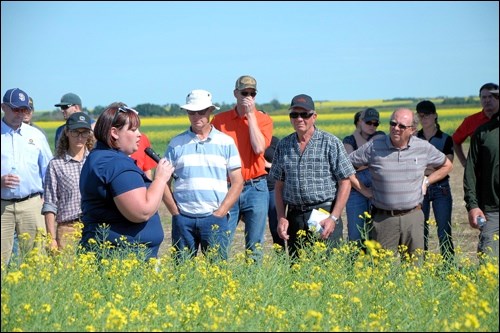SCOTT — Stu Brandt, head research agronomist, with the Northeast Agriculture Research Foundation, headquartered in Melfort, talked about phosphorous, and the risks of phosphorous application with seed placement, at the annual Scott Reseach Farm Field Day July 15.
Passionate about soil health, he started out by saying, “we have been taking nutrients out of the soil for 100 years. It’s catching up to us.” Low phosphorous is definitely a problem in Saskatchewan, he said. Soil test averages for phosphorous in Saskatchewan are 14 parts per million compared to 21 in Alberta and Manitoba and 41 in Ontario. There are even places in Saskatchewan with only seven ppm. “We cannot grow high yield crops on land with seven ppm phosphorous,” Brandt said.
With every bushel of canola harvested from a field goes approximately a pound of phosphorous. To boost yield, producers tend to use nitrogen, but Brandt suggested that could sometimes be a waste of money if the phosphorous issues aren’t fixed first.
That being said, about 25 pounds per acre of phosphorous is the maximum that can be placed with canola seed. Any more than that damages the seed. Brandt believes, however, the idea that all phosphorous has to be placed in the seed row is “oversold.” As the crop and roots develop, phosphorous will be accessed from mid-row bands as well.
He encouraged producers to build up the phosphorous levels in the soil, noting that it would also serve as a protection against high phosphorous prices in the future. He also cautioned them about the difference between actually replacing phosphorous versus using a product that merely enhances the ability of plants “to mine it out of the soil.”
Other speakers pointed out they have found a 25 per cent increase in lentil nodulation with phosphorous and that a big response to phosphorous has been seen in wheat.
Nicole Philp, an agronomy specialist with the Canola Council of Canada, spoke about the multi-year Ultimate Canola Challenge — this year focusing on the results of boron application. Standing in front of the flowering test plots, Philp noted that there were little visual differences at this stage but the tests will be taken all the way to harvest so yield comparisons can be made.
In addition to four test plots in Western Canada, there are also18 full-scale trials in progress. Philp said farmers are welcome to run their own trials and the protocol for doing so is available on the Canola Council website. In particular, a check strip is always required. When it is time to harvest, swathing should first be done down the middle of each area to ensure there is no mixing between the check strip and the test crop.
Jessica Weber, who grew up in Landis and is now WARC general manager, also addressed some aspects of canola production, in particular tests performed on results from changing seed size and seeding rates. The dividing point was 1.9 millimetres, so some plots were seeded with seed smaller than that and some with seed larger.
Again, there was not much visual different in the canola plots, although Weber said, she had hoped and thought the larger seed would have done better in this year’s drought conditions.
Seeding rates showed more of an effect. Weber noted an advantage of a thicker crop is that canopy closure is achieved sooner, helping with weed control. In addition, canola with more room to grow will branch out more before flowering and setting seeds. This creates more disease risk, meaning money saved on seed could end up being spent on treatment. Weber also pointed out that it only takes two per cent green seed to go from a number one to a number two grade.
Speakers at the event also covered several topics on pulses, including agronomy of faba beans, pea variety trials and soybean trials.



